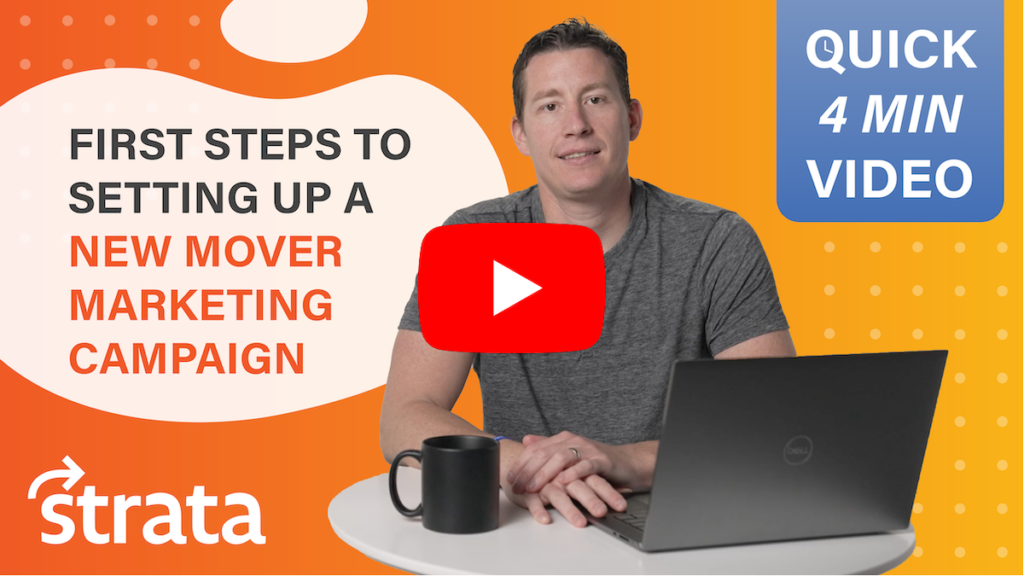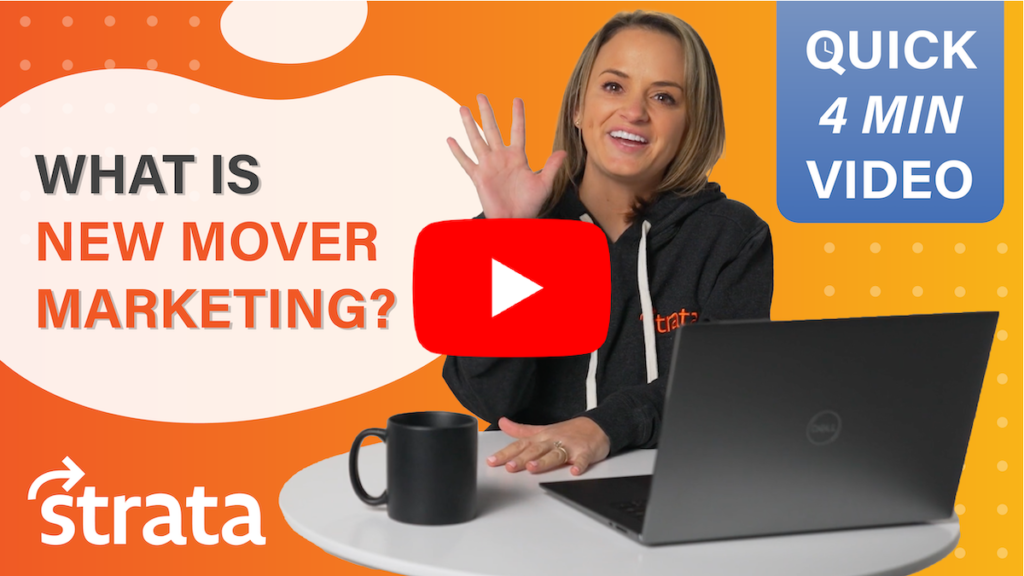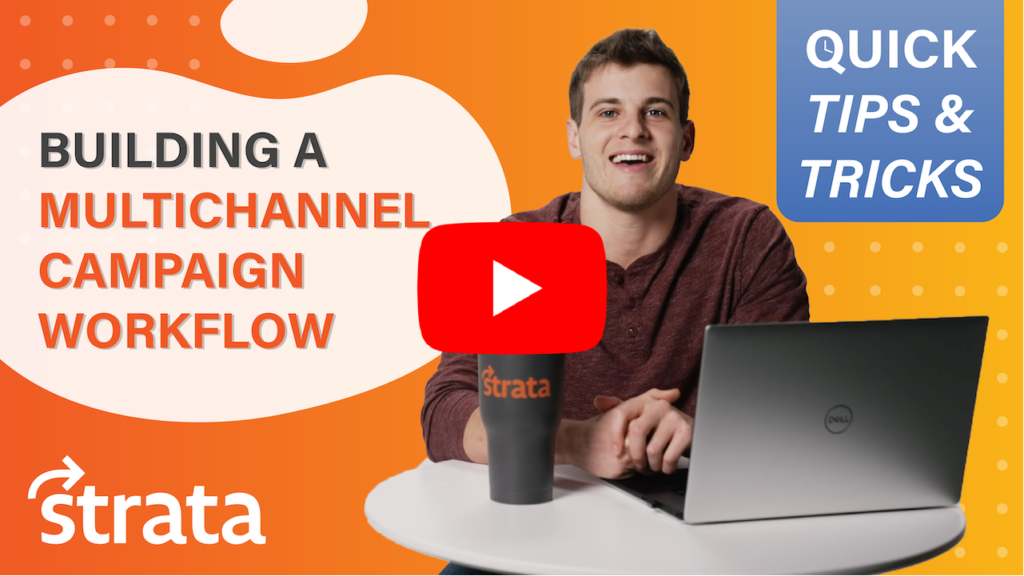Key Takeaways from SHSMD Connections 2022
Back at it Again!
It was great to see everyone at SHSMD 2022 in National Harbor, MD! With our new, brightly lit and eye-catching booth backdrop, we were able to meet new contacts – as well as catch up with current clients! The light and inviting atmosphere of our booth made it a great space to discuss marketing goals and showcase some of what we do here at Strata.
With SHSMD 2022 wrapped up, we’re excited to see how our connections grow, and how we can continue to help healthcare marketers and others with offerings beyond just new mover marketing. Whether it’s patient acquisition, talent acquisition, or promoting your service lines – we’re here to take your marketing to the next level. With that said, here are a few of our key takeaways in case you missed the show or didn’t get to stop by our booth this year.

The Conference in Review
At the beginning of the show, the team first joined other SHSMD attendees at Monday morning’s keynote — delivered by Suneel Gupta, a bestselling author, host of an American Express docuseries and podcast, and Visiting Scholar at Harvard Medical School. He spoke on the importance of long-term successes coming from short-term embarrassment, and explained that by gathering people who will challenge, encourage, work alongside and coach you, you’re becoming “backable.” He also emphasized that putting yourself out there only helps you get better at what you do – and that it’s important to be “backed” by the team you’ve assembled.

From there, the team moved to breakout rooms to learn a bit more about the needs and challenges that healthcare marketers currently face. We attended sessions surrounding digital and AI learning, nursing acquisition and retention, media buying innovations, and more.
A big topic was the idea that – as we’re continuing to traverse the digital age, it’s important that healthcare providers meet their potential patients and talent where they are. Whether someone is looking for an urgent care center, a primary care provider, or employment, the goal is to remain end-user focused. When marketing healthcare services to people in your area, it’s vital (no pun intended) to utilize demographic and psychographic data for the targeted population that your healthcare center serves. Because of this idea and the rise of ethical marketing, we’re seeing just how tactful marketing campaigns – both print and digital – need to be in order to be successful and worthwhile. Strata is well versed in this notion, and the atmosphere and chatter at SHSMD 2022 simply reiterated and expanded upon what we know to be true. Whether you need marketing that will facilitate patient acquisition, talent acquisition, or service line promotion, we’re here to make smart happen. We can help streamline your marketing to reach the talent you need and the customers you want. Right where they are.
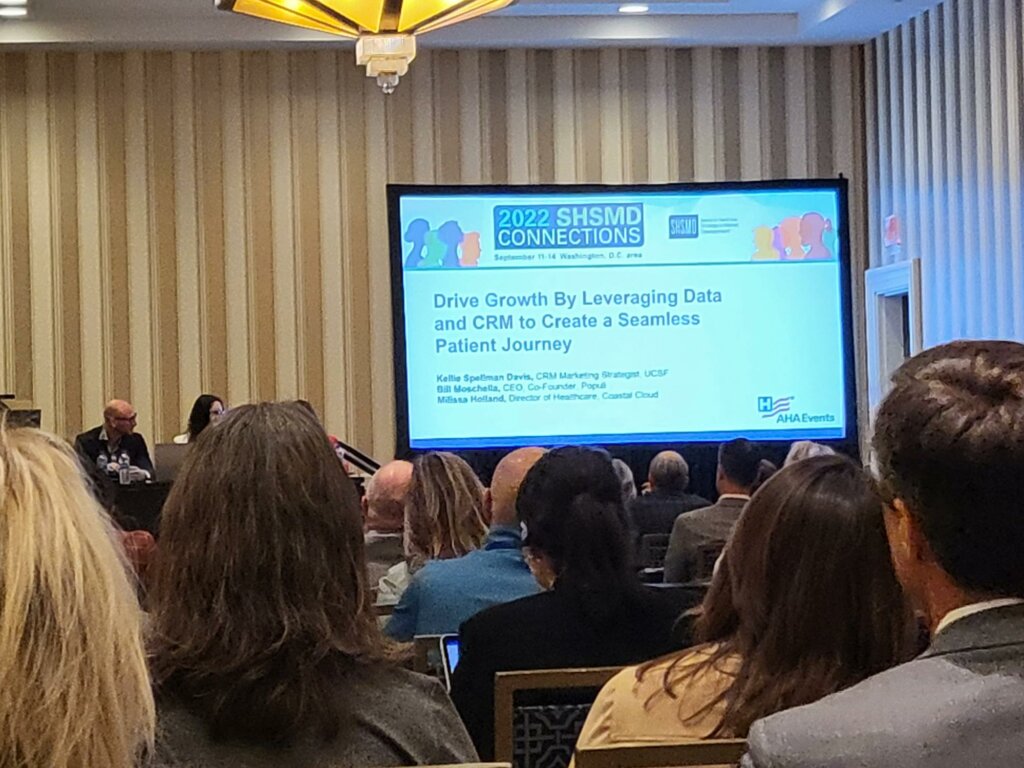

Some Final Thoughts
Last but not least – the conference reinforced the importance of good design to reach and engage your target audience! We’re glad that, here at Strata, personalized, eye-catching campaigns are right up our alley – and we have the experience and design talent to make them happen. Using demographic and psychographic data, as well as eye-catching imagery and layout, we create compelling pieces of print, direct and digital mail that follow branding specific to our clients and incorporate unique touches that help your system stand out among competitors.

Didn’t get to discuss your healthcare needs with us at SHSMD 2022? No worries. We’re happy to have a quick chat or set up a call. Contact us today!
A Strata YouTube Channel Original
In our past two blogs and their connected YouTube videos, we’ve given you a ton of basic information on new mover marketing. Now, it’s time to get into the first steps of starting a new mover marketing campaign. If you’re not super familiar with new mover marketing, it can be difficult to determine where and how to start, but we’ll lead you through the first things to do and ensure you’re well prepared.
A Quick Refresher on New Mover Marketing
To give a brief refresher, new mover marketing is a specific, niche marketing tactic that’s designed to reach new residents in your area. It’s one of the most effective ways to bring in new customers that have just recently entered your specific target market. When it comes to new movers, they’re nobody’s customer, yet- so you must make a good impression at the same time they’re looking for your product or service.
First, Answer the Question – Is a New Mover Campaign Right for Your Company?
New mover marketing is continually gaining popularity, and fast. It’s currently up 3% since last year, despite any economic rough patches. Why? Because people are always moving. Whether it’s for a new job, family changes, the need to start fresh, or anything else – and that will never change. When someone moves to a new area, they’re almost solely focused on unpacking, organizing, and settling in. They’ll heavily rely on word of mouth (WOM) marketing and other advertising to learn and figure out all their new go-to spots.
However, all this doesn’t mean that new mover marketing is fit for every business. It’s important to realize how (and if) your business can benefit from new mover marketing, and when another type of campaign would make more sense. At Strata, we typically say that if your product or service is needed within the first 6 months of a move, you should be targeting new movers. Anything within that 6-month mark would be something that new movers need in their day-to-day lives after a move. For example, think grocery stores, dentists, vets, salons – the list is endless. On the flip side, anything after that 6-month mark will typically be something they already own/have and are looking to buy new, now that they’re settled in. A good example of this? A new car. The majority of people don’t move to a new town and automatically search for and buy a new car. New mover marketing is all about the new movers’ priorities, so it’s important to understand where your business falls within those priorities.
Start with the Right Data
The use of data is incredibly important for new mover marketing, but it’s even more important to target the right people rather than all the people. You want your efforts to pay off – so sending new mover campaigns to residents who’ve already been established for years or have moved within the same zip code will more than likely be a waste of your time (and money). Sometimes, a smaller list will produce higher ROI, since you’re targeting actual, definite, new movers. Make sure you work with a reliable and well-versed company to ensure quality data over quantity of data. To learn more about the importance of quality over quantity, check out this blog.
What’s Next
Now you have the first few steps to starting your new mover campaign – but don’t stop there! In the video below, Connor, a member of our Strategic Sales Team at Strata, will go into the next set of steps you’ll take to create the best new mover marketing campaign possible. Check out the video by clicking below, and if you’re ready to take these first new mover marketing steps with Strata, contact us today.
Untrue & Debunked
With years of experience, we’d say we’re experts in direct mail marketing. But we’re not just the mail people. We provide highly impactful direct mail marketing that cuts through today’s digital noise to deliver a tactile experience and leave a lasting impression. That’s why we’re well versed in all of the misconceptions about direct mail floating around out there, and can tell you exactly why they’re untrue. Follow along as we debunk the 6 misconceptions of direct mail.
Misconception 1: Direct mail is past its heyday
Once in a while, we hear people speculate and assume that direct mail is past its peak – but just because direct mail has stood the test of time, doesn’t make it outdated. It’s been around for a while for a reason, and has evolved and changed over time – with the times. In fact, in a recent IAB survey, six out of ten marketers prefer direct mail over other offline channels and still include it in their direct marketing strategy today.
These days, direct mail breaks through the digital noise and is unique and different than other marketing tactics. It brings about nostalgia, as people enjoy the feeling of paper in their hands, similar to enjoying paperback books over kindles. Plus, for every 36 emails you receive (on average), you get 1 piece of mail in your mailbox. The possibilities are quite endless, with many exciting design opportunities and options. Really, direct mail is only boring and old if you make it that way.
Misconception 2: Compared to other tactics, direct mail doesn’t provide ROI
This one couldn’t be further from the truth. Don’t believe us? Here are just a few stats to back us up. The average lifespan of an email is 17 seconds, compared to direct mail’s average lifespan of 17 days. Up to 90% of direct mail gets opened, compared to only 20-30% of emails. Per USPS, 98% of people check their mail daily and Americans spend upwards of 30 minutes with their mail on a single occasion. Direct mail open rates can reach up to 42%. Recipients of direct mail also “purchase 28% more items and spend 28% more money than people who don’t get that same piece of direct mail.” Direct mail gets response rates 10 to 30 times higher than digital channels, according to the DMA (Direct Marketing Association).
Basically, direct mail usually does very well in terms of ROI, and it can (and should) be tracked – so make sure you’re getting the most out of it by making it trackable with the use of digital touchpoints.
Misconception 3: Direct mail marketing is expensive
When people think of print, they sometimes think of high-cost, but that’s not always the case. If you have a quality list and are getting the most out of each mailer you send, direct mail won’t seem all that expensive. What do we mean by a quality list? If you’re sending to strategic, particular contacts – not just any contacts, your ROI will be worth the price.
Additionally, print often gives you more for your money while other marketing practices alone may not (for example PPC, social media ads, email marketing platforms, and more). According to the stats, mail marketing is much more likely to be seen and paid attention to.
Misconception 4: Millennials and younger don’t like or pay attention to direct mail
Direct mail isn’t just effective for older audiences. Actually, 73% of American consumers (in general) say they prefer being contacted by brands via direct mail because they can read or review the information at their leisure. And, 41% of Americans of all ages look forward to checking their mail each day.
Millennials, specifically, like to feel important and seen, so the personalization opportunities of direct mail make for great millennial marketing. To add to this, many millennials and Gen-Z-ers have digital fatigue and find taking a “break” with print to be often enjoyable, and it “should be no surprise that those raised on the internet are best able to tune out online ads.” They also have shown to have a lot more trust in print resources than in digital.
Misconception 5: Direct mail works on its own and doesn’t integrate with other channels
These days, direct mail is actually an excellent touchpoint among many, especially when conducting a multichannel marketing campaign. And, we’d even say that combining tactics, even if it’s just two, is usually the way to go. In a recent study, a whapping 68% of marketing respondents saw that combining digital and direct mail increased visits to their websites.
So, how do you integrate physical with digital? By using a URL of a landing page or website, a PURL (personalized URL), BRC (business reply card), or a QR code. Any of these can be used to lead the viewer to a digital touchpoint. These can all also be used to measure attribution and better understand your target audience, and the emails and other information acquired from BRCs or online landing page forms can be used for email marketing, targeting customers with digital advertising, and sending further communication.
Misconception 6: Direct Mail = Junk Mail
Unlike junk mail, direct mail is focused, targeted, relevant, ROI-producing, and uses a quality send list. For more on why direct mail isn’t the same as junk mail, check out our blog, “Direct Mail vs. Junk Mail”, here. Strata can be a resource for direct mail with a surgically targeted list of prospects that are not only more likely to have a need for your project or service, but are also more likely to respond.
Now that it’s a bit clearer that direct mail is relevant, effective, and can be a huge part of the bigger picture of a marketing strategy, you may be interested in giving direct mail marketing or multichannel marketing a try. If so, give us a call.
A Strata YouTube Channel Original
In one of our recent blogs and its connected YouTube video, we went over the basic ideas behind new mover marketing. Now you may be thinking, what do I do with all this information? The next step is choosing the right new mover campaign partner. It can be overwhelming deciding on a marketing or new mover business that’s right for you to partner with. Luckily, we’ve compiled a list of all the different qualifications you should be looking for in a partner.
What’s New Mover Marketing Again?
As a quick reminder, new mover marketing is a specified, niche marketing tactic that’s designed to reach new residents in your area. It’s focused on bringing in new customers that have recently entered your target market. Why’s it so important – and furthermore, why does it work? It helps your company make a strong first impression at the same time someone is looking for your service.
The Qualities that Make a Good Partner
You don’t want to just choose a random new mover partner or even the first one you stumble upon. It’s important to put thought and consideration into your choice, so that you can make the best decision for your business. Make sure your partner has a bit of background on your company and understands your budget, time, size, and end goals. Remember, what you put into your search is what you’ll get out of it.
What if I Still Don’t Know Where to Start?
While you might have tons of information in front of you, deciphering this information and sifting through it all can be difficult and overwhelming. Here are a few things to do to make your search just a bit easier.
First, figure out the size of your industry, how sales have been, and what goals you want to set. All of this will allow you to pick a business that’s best suited for your type of company. The more information you can collect, the easier it’ll be to compare the strengths and weaknesses of each potential partner.
Additionally, you’ll definitely want to choose a partner that has a focus on lists and good data. This data should include demographics, psychographics, behavioral, and business-to-business firmographic information. The more specific data you can get, the better you’ll be able to target new movers and bring in more loyal customers!
While all this might seem like a lot to tackle, it’ll be worth it in the end when you have successful and effective new mover marketing campaigns.
Next Steps
You now have a baseline of how to choose the right new mover campaign partner for your business, but it doesn’t end there! Be sure to watch the video below, where you’ll hear from Rob, a member of our Strategic Sales Team at Strata. He’ll explain choosing a partner that best represents your business, in a bit more depth. Or, if you’re ready to choose your next new mover campaign partner and think it may be Strata, contact us today.
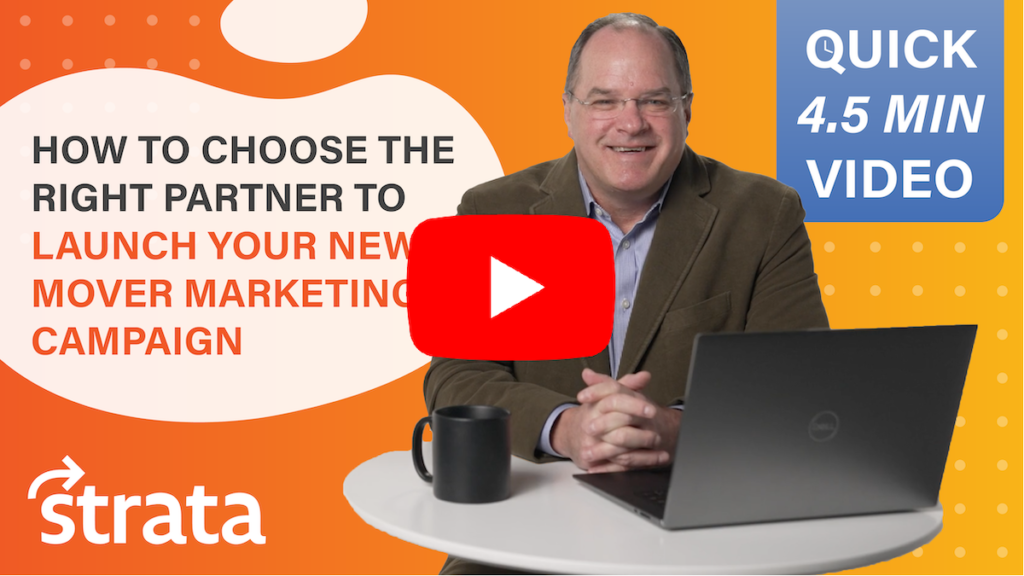
& Why They Matter
As you may know, new mover marketing is a big segment for Strata and an offering we’re quite proud of. We believe we do it best – not only because of our experience and skill, but because of the multiple channels we use, the data we provide and incorporate, and the digital touches we implement. We’ve had trust in, and have been executing, great new mover campaigns for several years now. It’s no wonder we have an eye on new mover trends that may arise and behaviors within this segment – but we’re not sure anyone predicted or was prepared for the shift in the new mover market that happened at and after the onset of the pandemic. Today, we’re looking at how the new mover market has changed since March of 2020, and the increased need for new mover marketing solutions that it’s caused.
Stats You Need to Know
To get started, we wanted to give you a few recent new mover statistics to take in and think on:
- A fifth of US adults moved or knew someone that did due to the pandemic.
- Over 110,000 people moved away from New York City between February and July of 2020.
- 487% more people moved out of NY in 2020 than in 2019.
- Although there was no “exodus” away from urban areas that some were claiming, people did and do seem to generally be “drifting towards the suburbs”.
- Families have mostly chosen to move to the suburbs, while those living alone have more often chosen to move to metropolitan areas (In the first half of 2021, 7 in every 10 people who moved into urban areas were those living on their own).
- 35% of moves related to Covid-19 happened because of financial hardships.
- 36% of movers in a recent study claimed their reasoning for moving to a new place was because they felt safer there.
- 10% of them indicated that they moved to places with less stringent Covid-19 restrictions.
Overall, the pandemic has shown to accelerate some moving trends that have already been underway – and also create a few new ones. This, of course, has also had an impact on the effectiveness of new mover marketing (marketing specifically targeting new residents in your area).
What’s Causing all the Movement?
There are several reasons people are moving, some of them which we stated in the statistics above – and others that we’ll get into now. First and foremost, a big reason many have moved and are moving is financial stress. Many are moving to less expensive housing and apartment living to cut costs during these financially tough times. Additionally, apartment amenities or “big city” expenses that were previously valuable became almost meaningless during the peak of Covid-19, causing apartment-dwellers to rethink their living expenses.
Due to increases in work-from-home life and more flexible working hours and situations, people are craving more space. Because of this change, many are moving to larger spaces where they can work more comfortably. Additionally, they’re moving to where they truly want to be instead of where they previously “had” to be for their in-office employment.
For some people in different areas around the country and different industries within the workforce, finding employment during the pandemic has been tough, so this has caused some to find employment elsewhere and relocate.
And lastly, throughout the pandemic, the realization or reminder of the importance and need for family support during times of crisis and distress has been prominent – so many have moved and are still moving to be closer to the ones they love.
Overall – no matter where, when, or why they’re moving, people are definitely on the move since the onset of Covid-19.
How These Numbers (And the Causes Behind Them) Make Marketing to New Movers Essential
As you can probably imagine, as people move out of your area, you lose those customers, but as people move in, the opportunity arises for new customers to replace the old. So, more movers mean more new opportunity – but not if a competitor snatches them up by getting to them first and making a good impression.
That’s why it’s so important to be the first to put your brand in front of this niche audience, and to deliver quality marketing that welcomes, attracts, and entices them. New mover marketing programs are made to keep you connected with these new residents on a consistent basis, so that you’re never missing out on a new customer that, if targeted correctly, could become a loyal, repeat one.
Strata’s program, SmartMove, is a robust, multichannel, multi-touch, new mover marketing program that helps you find the right time and place to reach your target audience, right as they move into your surrounding area. We’ll help you reach this audience throughout their customer journey to build brand loyalty and trust and turn them into long-term, devoted customers. Interested in hearing more of our thoughts on the new mover market, or ready to start your first (or next) new mover campaign? Give us a call.
A Strata YouTube Channel Original
New mover marketing is all the rage right now, and for good reason – but getting started can be a bit confusing if you’re new to the game. That’s why in this blog, along with in our most recent YouTube video, we’ll help you achieve a clear understanding of what New Mover Marketing is, and how it could be used for your business. First, we’ll go over how new mover marketing is defined, what a new mover is, and how this marketing technique can be utilized to reach and acquire new customers.
What’s a “New Mover”?
In general, a new mover is someone who’s recently moved to your area, and since they’re new, is looking for a new doctor, dentist, grocery, vet, and more, to establish trust in – and hopefully frequent.
Is New Mover Marketing the Same as Regular Marketing?
In short, no! New mover marketing is a specified, niche tactic that helps you reach new residents in your area while they’re actively establishing new routines and purchasing habits. It’s all about making a strong, quality impression at the same time someone is looking for your services. Different than regular marketing – where you’re mostly informing current customers about new products, services, or promotions, new mover marketing tactics focus solely on bringing in new customers that have just entered your target market.
The Importance of New Mover Marketing
New mover marketing is one of the best ways to gain and retain more customers. If you really think about it, new movers have no customer loyalty to any specific business – yet. They tend to be more receptive and open-minded to marketing campaigns from any business in their new area. They’re also more likely to listen, and are easily attracted to the first business that reaches out to them (so you need to act fast)! Yet, don’t act too fast, because it’s also important to market yourself correctly and effectively. Remember, you typically only get one shot at a first impression, so make sure you present your business the right way.
Let’s quickly go through an example of how exactly a new mover marketing campaign helps you attract new customers. Suppose a new family moves into your town. They’re unfamiliar with what services/businesses are available. Soon after move in, they see a mail campaign for your grocery store in their mailbox. Because they’ll (sooner rather than later) need to go get some groceries, they may be more inclined to visit your store instead of another because you reached out and introduced your store and its services, first. As long as you market yourself correctly, you now have a new, and potentially loyal, customer!
Next Steps
With new mover marketing, the opportunities are endless! Be sure to watch the video, below, to dive a bit deeper. You’ll hear from Strata’s Director of Marketing, Caitlin, as she goes through more specifics. Or, if you’d like to get started on your next new mover marketing campaign and discuss this concept with one of our experts, contact us today.
Laying Out the Pros and Cons
We know it can be a long process to research, find, and decide on a marketing solutions company that achieves your objectives. We also know that the full package – good data, quality design, excellent messaging, great customer service, mailing and fulfillment, and quantifiable results – is the goal, but not always the outcome. Since we get asked about it from time to time, in this blog, we’re going to cover why you may want to choose to work with a marketing company over a CRM services company who also happens to strategize and launch campaigns. Before you make your decision, give this a quick read.
Not Always the “Path of Least Resistance”
First and foremost, although it may appear “easier” to partner with a CRM service to launch your campaigns (because they have access to CRM) – they don’t always have immediate access to other capabilities. For example, they likely don’t have in-house creative design, printing, fulfillment, and mailing, and if they do have some of them – they likely don’t have all of them to execute a turnkey campaign. The main focus of a CRM company is usually just that – customer relationship management. Their key offering is their ability to compile and supply lists – which they may be excellent at doing, but what will they provide in terms of other areas of expertise?
Because of the outsourced services they use (such as those listed above), CRM companies can’t always make campaign changes on the fly. They’re usually unable to print on-demand, have their artist make quick modifications, make last-minute changes to the mailing process, or most importantly, optimize the campaign based on results, midstream.
The Marketing Differentiators
So, what’s the alternative? Partnering with a marketing solutions company that offers expertise in everything from implementation to optimization. Marketing companies are often also connected directly to the list compiler, and even more than that, they’re usually more closely if not directly connected to everything else you’ll need and use during the campaign production process – from strategy to printing. Since many if not all of their services are in-house (including design, print production, fulfillment, and mailing), you can always make changes and improvements mid-stream and at rapid speed. They can simply call on their marketing team of strategists, artists, print production associates, and others to change gears, swiftly improving the efficiency of the program while it’s in progress and effectively increasing campaign ROI.
Additionally, marketing companies focus solely on marketing strategy and production, and the more years of experience under their belts of doing so – the better. Marketing execution is not an add-on to marketing companies. It’s what they do, day in and day out. And the right marketing company will be able to simultaneously execute concurrent campaigns, whether single-touch or many, with corresponding digital to (targeted, specified) customers and prospects. If you’re lucky or do your research, you’ll find a marketing company that also incorporates backend fulfillment, seamless management, granular personalization, and attribution, and will be a team of dedicated experts, creators, innovators, and most importantly, marketers. You get the picture we’re painting. It’s important for a marketer or marketing team to also value and provide quality execution and customer care to every client, and ensure you have the reporting, understanding, and peace of mind you need, with 1:1 attribution, automated data exchange, and a detailed dashboard.
Next time you’re debating, think through this blog first. Do you just need a simple marketing campaign with CRM first, or do you need a multi-touch, well-focused marketing campaign with accurate, up-to-date lists and quality attribution?
What You Need to Know
In today’s world of marketing, we’re constantly surrounded by buzzwords – both old and new. As we evolve and keep up with the newest technology and trends, these buzzwords evolve as well. Yet, some buzzwords – like “Every Door Direct Mail”, otherwise known as EDDM, have stood the test of time for quite a while. In this blog, we’re breaking down this buzzword, walking you through its positives and negatives, and explaining when your company should or shouldn’t use it.
What is EDDM?
Every Door Direct Mail (better known as EDDM) from USPS is a blanketed mailing approach sent to potential customers near your business. USPS utilizes a mapping tool that holds demographic data based on census reports, such as age-range, household size, and income. Factors like these can help your company choose the routes you’d like to deliver your mail piece(s) to. Additionally, you can schedule that delivery for any time mail gets delivered.
You may create the mailer yourself, but it’s recommended you work with a company (like Strata) to help you design both professionally and effectively. The USPS website states, “Based on your unique business needs, either create an EDDM mailing yourself or get help with any part of the mail design, printing, preparation, and drop-off process using USPS affiliate vendors or find a local printer in the USPS Printer Directory.”
What Does it Cost?
The cost of EDDM varies, but it’s usually a lower cost option for marketing mail (which we’ll go over later on in this blog). You first have to choose between two options, EDDM Retail and EDDM BMEU, which you can read more in-depth about, here. The costs associated with these options are as follows:
- EDDM Retail® USPS Marketing Flats – $0.20 per piece
- EDDM BMEU USPS Marketing Mail Flats – as low as $0.168 per piece
What’s Good About EDDM?
EDDM is a good option to have if your marketing budget is low. It’s also possible to use it as a marketing test-run to see what audience members are most likely to respond to your communication (especially if you don’t have the budget for reporting).
It’s most often used for generalized, non-specific marketing awareness or brand campaigns. If you simply want to get the word out there – to anyone and everyone about your business, EDDM is an option to consider. Using EDDM can help you to avoid high postage rates, as long as you have a smaller print job in one geographic area.
Why Should I Consider Not Using EDDM?
EDDM definitely comes with its trade-offs. With it, you’ll lose the ability to target individuals based on very specified credentials, and won’t have as much leeway when it comes to time-to-market. Additionally, if your EDDM campaign is too large the cost savings you’d get with postage would be practically meaningless due to the increase in production processing. Lastly, EDDM doesn’t give you any options in terms of personalization – which, if you’ve read some of our blogs, you know is important in direct mail campaign effectiveness and ROI.
What are the Alternatives?
Before using EDDM, think through other ways you can get your message across, and who you’re trying to get that message to. Instead of using a blanketed geographic approach, you may want to try a more specified campaign like our SmartMove services (personalized, multi-touch mail that’s sent specifically to new movers). This way, you can better pin-point your audience, and provide a better experience to those who receive your mail.
Or, maybe the best marketing strategy for your company isn’t even mail at all, or is mail that includes a digital touchpoint. A more multichannel campaign could be your answer.
EDDM isn’t for every company and its marketing strategy – but as experts in the industry, we can say that it works for some companies. Yet, there are many times a more targeted strategy, like our new mover marketing options, will work better. Wondering how you can get started on your next direct mail or multichannel campaign? We’re here to help. Simply contact us whenever you’re ready.
A Strata YouTube Channel Original
Figuring out your multichannel campaign workflow can be difficult (at first). At its core, a workflow should be a living, breathing thing, and you most likely won’t come up with the optimal flow right from the get-go, and that’s alright, you’re not really supposed to. When building a workflow, your goal should be getting to a point where you’re tweaking it throughout the campaign, not reengineering it. That said, in our most recent YouTube video of our Multichannel Marketing series, we go over best practices for creating this flow, and the ways in which you can make it work well for you and your company.
Are All Workflows the Same?
The answer’s no. Look at the construction of your workflow as an iterative process. Something you sit down with, leave, come back to, leave for another cup of coffee, come back to and test out, make calculations for, leave, come back to, leave for more coffee, etc. Go in with the expectation of optimizing it a handful of times. Remember, it’s personalized to you and your company’s goals.
Its Importance
Having the most effective campaign from the get-go is one thing, but building a workflow and truly thinking through a theory for that workflow is another. It allows you to better test and evaluate your campaign’s goals. If you begin to see a disconnect between your campaign goals and what you currently have after constructing a workflow and calculating your multichannel KPIs, you have a problem. But, the good news is that you can work to solve it before spending money, and possibly disrupting your reputation. This is one of the main reasons workflows are important to have – so you can catch any kinks before launching your campaign.
First Steps
When starting to create your workflow, there are a lot of framework options you can build upon. The video that we’re referring to in this blog is for building a ‘base’ workflow, but, for information on how to tweak your ‘final’ workflow, check out this video when you find some time.
A commonly used workflow strategy formulation starts with defining the highest and lowest levels of the marketing funnel that you want to address. You can have as many ‘funnel buckets’ as you want, and they’ll vary based on your industry and business model. Here are some basic ones that can be used:
- Awareness
- Consideration
- Evaluation
- Purchase
We recommend laying these out as lanes in a flowchart. It helps to visualize the different stages of engagement for your campaign members.
To see next steps for building your multichannel workflow, click on the video below. You’ll hear our Director of R&D, Harrison, go through best practices and tips and tricks for getting yours set up. Or, if you’d like to discuss this concept with one of our multichannel experts, contact us today.


